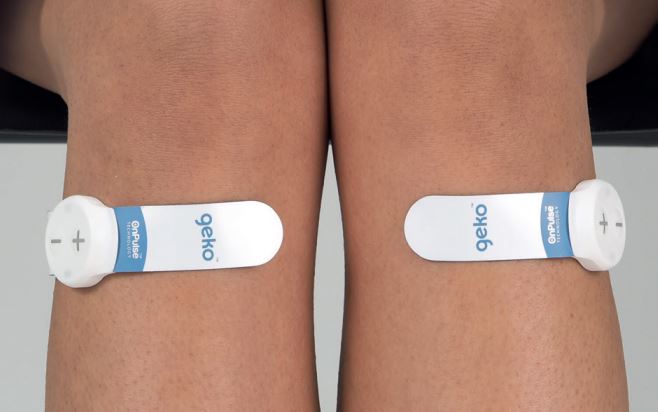The geko™ Device: The Future of DVT Prevention


Introduction
The geko™ device is revolutionising the landscape of deep vein thrombosis (DVT) prevention. This innovative solution is a game-changer, especially for immobile stroke patients who are contraindicated or intolerant to standard of care, Intermittent Pneumatic Compression (IPC) interventions.
Gentle Stimulus, Profound Impact
At the core of the geko™ device lies its ingeniously gentle stimulation of the common peroneal nerve, activating the calf and foot muscle pumps, resulting in increased blood flow in the deep veins of the calf, at a rate equal to 60% of walking without a patient having to move. Through its unique mechanism of neuromuscular electrostimulation the geko™ device prevents venous stasis – fundamental to DVT prevention1.
Validation Through Clinical Audit
A real-world in service evaluation conducted in the UK National Health Service shows the geko™ device is clinically proven to prevent VTE2. 1,000 immobile, hyper-acute stroke patients had their contraindication and/or intolerance to IPC reviewed and quantified. The audit showed that 29.5% of these patients were either contraindicated or were unable to tolerate IPC, revealing a significant unmet need for an alternative anti-stasis intervention.
The study measured VTE events at 90 days post-stroke. The data shows that the patients treated with IPC alone, as the standard of care, 2.4% suffered a VTE event, compared to a 0% incidence of VTE in patients prescribed the geko™ device alone. Patients prescribed the geko™ device also showed no adverse events and reported a greater tolerance of the device compared to IPC. The geko™ device provided an anti-stasis intervention where previously patients would have had no other intervention available to them, ensuring that there were no immobile stroke patients with a high risk if VTE without a mechanical VTE prophylactic intervention.
The geko™ device is also cost saving. NICE guidance (MTG19) recommends use of the geko™ device when other prophylactic methods cannot be used and estimates a cost saving of £197 per patient when the device is used for a period of 6 days2. The cost saving for this acute pathway is £237 for a period of 9 days.
Validation from the Field
Dr. Indira Natarajan FRCP (UK), Consultant Stroke Physician and Clinical Director of Neurosciences at The Royal Stoke University Hospital, attests that, "The geko™ device is now in routine use and has marked a turning point in our nursing practice." This innovative device fills the gap when other VTE prophylaxis methods are untenable, providing a lifeline for patients who would have otherwise had no intervention options.
Aligned with NICE Guidelines
The NICE Guidelines are evidence based guidelines for healthcare in England. They set out the services most suitable for most people with specific conditions or needs, and people in particular circumstances or settings.3
The significance of the geko™ device extends beyond anecdotal success. It aligns with NICE guidelines, recommended to reduce VTE risk when IPC is contraindicated or intolerable, through effectively preventing stasis in the deep veins of the calf, as demonstrated by A. Nicolaides and M. Griffin.4
Real-World Application: University Hospital of North Midlands NHS Trust
The University Hospital of North Midlands NHS Trust's clinical audit provides insight into real-world contraindications and tolerance to IPC. Of 1000 admitted stroke patients, 29.5% were not suitable for or unable to tolerate IPC. Herein, the geko™ device emerged as an alternative anti-stasis intervention, preserving patient well-being without adverse effects or skin irritation.
The geko™ device represents a paradigm shift in DVT prevention. By transforming limitations into opportunities, it stands as a testament to the marriage of medical innovation and compassionate patient care.
1 A. Nicolaides. M. Griffin. Measurement of blood flow in the deep veins of the lower limb using the geko™ neuromuscular electro-stimulation device. Journal of International Angiology August 2016-04
2 Natarajan et al International Stroke Conference, Hawaii 2019
3 NICE Guidelines, National Institute for Healthcare and Excellence, accessed 26 - 08 - 2023. Available at: https://www.nice.org.uk/about/what-we-do/our-programmes/nice-guidance/nice-guidelines#:~:text=NICE%20guidelines%20are%20evidence%2Dbased,prevent%20ill%20health
4A. Nicolaides. M. Griffin. Measurement of blood flow in the deep veins of the lower limb using the geko™ neuromuscular electro-stimulation device. Journal of International Angiology August 2016-04


.png)